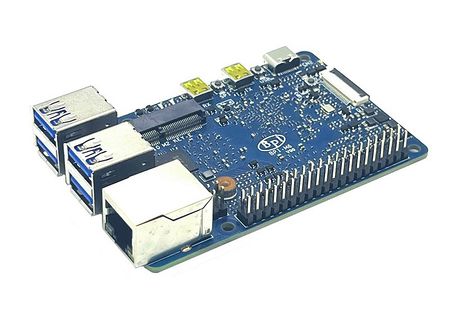Banana Pi M6 (BPI M6)
Deliveries:
South Africa: Price: R115, 2-4 working days.
International: Contact us for a quote.
Collections:
No Charge - 3 Appian Place, 373 Kent Ave, Randburg Effortlessly bridge legacy and modern technologies with our DB9 to USB Connector, enabling seamless connectivity between serial devices and USB ports.
All items subject to manufacturer's warranty. Extended 12 month warranty available at 20% of purchase price. t&c apply
Banana Pi M6
New Generation Single Board with Senary(Synaptics)
The Banana Pi BPI-M6, featuring the Senary (Synaptics) VS680 design, boasts onboard 4G LPDDR4 and 16G eMMC. Powered by the Senary VideoSmart VS680 with a quad-core Cortex-A73 (2.1GHz) processor, one Cortex-M3 processor, Imagination GE9920 GPU, and NPU with up to 6.75 Tops processing capability. This compact device also includes 4GB LPDDR4 memory, 16GB eMMC storage, 4 USB 3.0 interfaces, a gigabit network port, and HDMI-rx and HDMI-TX ports for versatile connectivity and display options.
Introducing the groundbreaking VideoSmart™ VS680 solution, a pioneering edge computing System-on-Chip (SoC) that seamlessly integrates a CPU, NPU, and GPU. This innovative multimodal platform, featuring an embedded neural network accelerator, is meticulously designed for perceptive intelligence, catering to a diverse range of applications such as smart displays, smart cameras, set-top-boxes, and media streamers.
The Synaptics VideoSmart VS680 stands as a multimedia powerhouse, amalgamating a Qdeo 4K video engine, an audio processor capable of far-field keyword detection and voice recognition, and a proprietary SyNap deep-learning accelerator (DLA). It also incorporates an enhanced Imagination PowerVR Series9 GPU for heightened performance. Noteworthy among its features is an Image Signal Processor (ISP) with HDR capabilities adept at managing two 4K cameras simultaneously.
While prior VideoSmart products focused on the streaming-video set-top-box (STB) market, the VS680 extends its reach to a broader array of smart-home devices. Particularly well-suited for devices like the Facebook Portal and other smart displays facilitating video calling, the audio processor can drive smart speakers or sound bars. When combined with the DLA, it not only manages on-device voice-UI functions but also serves as the interface for a cloud-based digital assistant.
The DLA collaborates with the dual ISP to execute neural networks on video streams from front and rear cameras, enabling functions such as face ID, object recognition, and security monitoring. The Qdeo engine, capable of driving two displays simultaneously, empowers the device to manage a 1080p touchscreen panel in an STB while concurrently streaming content to a 4K TV.
Hardware Specification of Banana pi BPI-M6
| CPU | Synaptics VS680 quad-core Cortex-A73 (2.1GHz) and One Cortex-M3 processor |
| GPU | Imagination GE9920 GPU |
| NPU for AI | Up to 6 .75Tops |
| Memory | 4 GB LPDDR4 |
| Storage | MicroSD slot with support for up to 256GB expansion and 16G eMMC flash with support for up to 64GB |
| Network | 10/100/1000 Mbit/s Ethernet ,Optional WiFi USB dongle |
| Video | 1 x HDMI 2.1 (up to 4K@60Hz with HDR, CEC, EDID) out, and 1 HDMI in Port |
| Audio Output(s) | 1 x HDMI digital output |
| Display | MIPI DSI interface |
| M.2 interface | M.2 Key E(PCIe + MIPI CSI) |
| USB ports | USB 3.0 PORT (x4) |
| GPIO | 40 Pin Header : GPIO (x28) and Power (+5V, +3.3V and GND). GPIO pins can be used for UART, I2C, SPI or PWM |
| Switches | SPI boot and U-boot |
| LED | Power Status and Activity status |
| Power Source | 5 volt @3A TYPE C |
| Size & Weight | 92x60mm, 48g |
| OS | Android and Linux |




